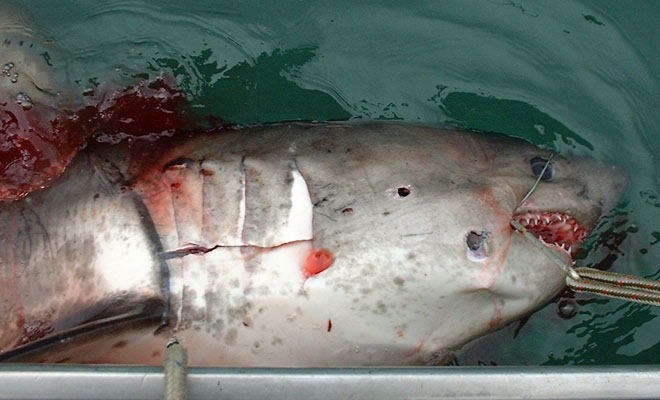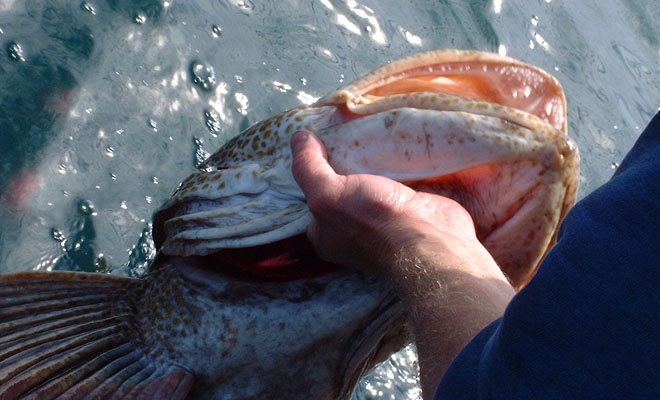
Salmon Shark
Salmon shark are a member of the mackerel shark family and resemble the Great White. Salmon shark have dark grey backs, with dark blotchy patches on their sides, and white bellies. The average size of these huge sharks is between 6-8 feet and 200-400 pounds. They have been known to reach over 11 feet and over 1,000 pounds, with a life expectancy of at least 25 years.
Named after their diet, huge numbers of salmon shark follow the migration of their favorite fare, pink salmon, giving anglers plenty of opportunity to hunt for schools! Use a heavy-action rod and reel, with at least 80-pound line, and a steel cable leader; 10 to 20 feet of 1/8″ braided steel wire is recommended. A salmon carcass hooked on a very large J-hook is the typical bait when seeking this prey.
We highly recommend picking an experienced charter operator for this type of fishing. Salmon sharks are capable of pulling people overboard and reeking havoc with a boat. Be prepared for the fight of your life when hooking into one of these fierce, unpredictable monsters. Do not bring these fish into your boat alive! Use a gaff or harpoon to stabilize and a firearm to subdue the shark. Once the shark is dead it should be bled, gutted, and put on ice immediately for the best care of this tasty meat. Several Valdez charter captains offer salmon shark fishing.
Valdez Chinook Salmon: Kings
Kings have a blush-green back, with silver sides, white bellies, and irregular black spots on their backs dorsal fins and tails. Ocean caught salmon, “feeder kings”, can be caught year-round in the waters of Prince William Sound. These immature salmon, weighing from 2 to 30 pounds, are caught in the ocean before returning to spawn. Mature kings average between 33 and 36 inches, but may be up to 60 inches. The average weight is between 10 and 50 pounds, but they can grow to well over 60 pounds. Strong rods with large reels are recommended for catching king salmon. Trolling with herring is a common way to fish kings in the ocean.
Valdez Chum Salmon: Dogs
Chum or dog salmon are the second largest of the Pacific salmon. Ocean caught chum are silvery bluish-green, with black speckles, and white bellies. As chum near freshwater they darken with dark green bars and purple blotches. Spawning males grow a drawn out hooked snout and enlarged teeth. Chum average in length from 20-30 inches and weigh from 8-20 pounds.
Sockeye Salmon: Reds
Sockeye are a delicious and rewarding sport fish to target. Most of the sockeye salmon caught in Valdez are caught in the Robe River along a stretch of the stream that is fly-fishing only.
In saltwater reds display bluish-green tops and shiny silvery sides and bottoms. Males develop a hump back with a hook jaw as they return to freshwater. Sockeye develop green colors on their head while their bodies turn red when spawning. Sockeye can grow as long as 33 inches and weigh an average of 8 pounds.
To fish for them, you can use a 7 to 8-foot medium bait casting or spinning rod and reel combination with 150 yards of 10-20 pound test. In the freshwater ‘Fly Fishing Only’ area of the Robe River you can use a 7 to 8-weight rod that is 9 to 9½-foot with a matching reel size holding 100 yards of 30-pound backing, and a 10 to 15-pound leader from three to five feet long. Use hooks anywhere from size 3 to 7. Weights can be used as long as they are 18 inches or more away from the fly.
Sockeye meat has a firm texture and is considered to be very flavorful compared to other salmon.
Light to medium-action spinning and fly rods offer the best angling. These salmon will readily hit spinners, spoons, streamers, and jigs. Casting and retrieving directly in front of a chum’s nose will usually trigger a strike. Chum can be ocean caught year round and edible if eaten fresh from the ocean. The meat deteriorates quickly once it has entered freshwater.
Rainbow Trout
Rainbow trout have olive colored bodies with pink to red striping that runs lengthwise on the sides, white bellies and black spots on the top. Rainbows vary between 12 and 36 inches.
In an effort to establish a rainbow trout population, fish are released each year into Worthington and Blueberry Lakes in the Thompson Pass area as well as Ruth Pond in downtown Valdez. Rainbows are ravenous feeders and will hit an assortment of bait, lures and flies.
Arctic Grayling
Arctic Grayling have red or purple spots decorating their dorsal fins, brown tail and anal fins, and pelvic fins marked with pinkish-orange stripes. They have a dark back, and iridescent grayish-pink sides.
For fishing grayling, use an ultra-light weight, 6 to 7 foot rod with matching reel and 2 to 4 pound test. Bait, lures, or flies will work when fishing for grayling. It is important to pay attention to the feeding patterns to recognize how and what type of fishing will be the most successful. Anglers can fish for grayling all year long.
Mature Arctic Grayling have an average size of 12 to 20 inches and weigh between 1 and 3 pounds. North of Valdez, the Gulkana River has some of the best Arctic Grayling fishing accessible by road.
 Valdez Lingcod
Valdez Lingcod
Lingcod have a unique dark brownish-green color with copper blotches and have unusually large mouths, bearing 18 sharp teeth.
Lingcod can be fished from July 1 through December 31. In 2007, regulations state that in order to keep a lingcod it must be over 35″ and there was a two per day and four in possession bag limit. The average lingcod is 20-35″ and is between 20-30 pounds; however they can reach over 60 pounds.
Common fishing techniques include jigging and mooching. Use medium-heavy action rods and reels. Fishing is best on the bottom, from 30-300 feet off steep rocky banks and reefs. Lingcod are aggressive, excellent fighting sport fish and they are a very tasty white fish.
Valdez Rockfish
Rockfish are a delicious gamefish to catch. They grow slowly and live exceptionally long. Mature rockfish vary in size from 4 to 40 inches, averaging between 20 and 24 inches. Colors range from black to fluorescent orange. One of the most popular rockfish to target is the yelloweye (left).
There are three types of rockfish; slope rockfish, which live the furthest from shore in deep waters along the continental shelf; shelf pelagic rockfish, which live closer to shore, along the shallower continental shelf waters; and lastly, shelf demersal rockfish, living in the shallower, rocky bottom waters near the shore. Many species have a strong preference for a specific area and if any of these fish are removed and released elsewhere, their impressive memory will navigate them back to their preferred area.
Medium-action spinning rods or baitcasting with 10-15 pound test line are recommended. Casting and retrieving, jigging with small spinners, spoons, bait or streamers works well. Rockfish are best caught from the surface to 60-foot depths. If caught any deeper, the fish experience gas expansion in their swim bladders and if pulled to the surface too quickly, their eyes and stomachs can bulge due to rapid decompression. The white meat of a rockfish is very delicious.
Valdez Pink Salmon: Humpy
The Pink salmon run in Valdez is incredible! The Solomon Creek hatchery releases over 100 million pink salmon fry every year, resulting in millions of returning salmon. Because of their two-year cycle, the runs are stronger in even numbered years.
Humpies are dark-shiny blue on top, with silvery sides, sporting large black spots on their back and tail fin. When spawning, the male’s color gets brown to black with white bellies and they develop a humpback and hook nose. The females get undertones of olive-green with lighter colored bellies.
Fishing for pinks can be done with a medium to light action rod from 6-8′, and a spin or bait-casting reel with 200 yards of 8 to 10-pound test. Use medium spinners or spoons in the ¼ to ½ -ounce range from the beaches at Allison Point. If fishing from a boat, troll and cast along the shoreline.
Humpies have an average weight of 3.5-4 pounds, and an average length between 20 and 25 inches. As the name implies, the meat of the humpy is pink.
There is a new Kids Pink Salmon Derby in Valdez where kids under 16 years old are encouraged to put their fishing skills to good use. Along with a little luck and determination they may just catch the biggest fish in the tournament.



 Valdez Lingcod
Valdez Lingcod